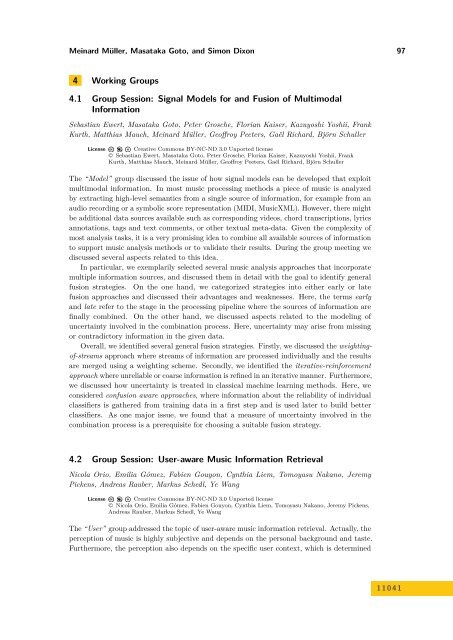Volume 1, Issue 1, January 2011 - DROPS - Schloss Dagstuhl
Volume 1, Issue 1, January 2011 - DROPS - Schloss Dagstuhl
Volume 1, Issue 1, January 2011 - DROPS - Schloss Dagstuhl
You also want an ePaper? Increase the reach of your titles
YUMPU automatically turns print PDFs into web optimized ePapers that Google loves.
Meinard Müller, Masataka Goto, and Simon Dixon 97<br />
4 Working Groups<br />
4.1 Group Session: Signal Models for and Fusion of Multimodal<br />
Information<br />
Sebastian Ewert, Masataka Goto, Peter Grosche, Florian Kaiser, Kazuyoshi Yoshii, Frank<br />
Kurth, Matthias Mauch, Meinard Müller, Geoffroy Peeters, Gaël Richard, Björn Schuller<br />
License Creative Commons BY-NC-ND 3.0 Unported license<br />
© Sebastian Ewert, Masataka Goto, Peter Grosche, Florian Kaiser, Kazuyoshi Yoshii, Frank<br />
Kurth, Matthias Mauch, Meinard Müller, Geoffroy Peeters, Gaël Richard, Björn Schuller<br />
The “Model” group discussed the issue of how signal models can be developed that exploit<br />
multimodal information. In most music processing methods a piece of music is analyzed<br />
by extracting high-level semantics from a single source of information, for example from an<br />
audio recording or a symbolic score representation (MIDI, MusicXML). However, there might<br />
be additional data sources available such as corresponding videos, chord transcriptions, lyrics<br />
annotations, tags and text comments, or other textual meta-data. Given the complexity of<br />
most analysis tasks, it is a very promising idea to combine all available sources of information<br />
to support music analysis methods or to validate their results. During the group meeting we<br />
discussed several aspects related to this idea.<br />
In particular, we exemplarily selected several music analysis approaches that incorporate<br />
multiple information sources, and discussed them in detail with the goal to identify general<br />
fusion strategies. On the one hand, we categorized strategies into either early or late<br />
fusion approaches and discussed their advantages and weaknesses. Here, the terms early<br />
and late refer to the stage in the processing pipeline where the sources of information are<br />
finally combined. On the other hand, we discussed aspects related to the modeling of<br />
uncertainty involved in the combination process. Here, uncertainty may arise from missing<br />
or contradictory information in the given data.<br />
Overall, we identified several general fusion strategies. Firstly, we discussed the weightingof-streams<br />
approach where streams of information are processed individually and the results<br />
are merged using a weighting scheme. Secondly, we identified the iterative-reinforcement<br />
approach where unreliable or coarse information is refined in an iterative manner. Furthermore,<br />
we discussed how uncertainty is treated in classical machine learning methods. Here, we<br />
considered confusion aware approaches, where information about the reliability of individual<br />
classifiers is gathered from training data in a first step and is used later to build better<br />
classifiers. As one major issue, we found that a measure of uncertainty involved in the<br />
combination process is a prerequisite for choosing a suitable fusion strategy.<br />
4.2 Group Session: User-aware Music Information Retrieval<br />
Nicola Orio, Emilia Gómez, Fabien Gouyon, Cynthia Liem, Tomoyasu Nakano, Jeremy<br />
Pickens, Andreas Rauber, Markus Schedl, Ye Wang<br />
License Creative Commons BY-NC-ND 3.0 Unported license<br />
© Nicola Orio, Emilia Gómez, Fabien Gouyon, Cynthia Liem, Tomoyasu Nakano, Jeremy Pickens,<br />
Andreas Rauber, Markus Schedl, Ye Wang<br />
The “User” group addressed the topic of user-aware music information retrieval. Actually, the<br />
perception of music is highly subjective and depends on the personal background and taste.<br />
Furthermore, the perception also depends on the specific user context, which is determined<br />
1 1 0 4 1













